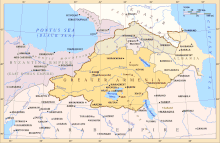Battle of Bagrevand
| Battle of Bagrevand | |||||||
|---|---|---|---|---|---|---|---|
 Bagrevand map | |||||||
| |||||||
| Belligerents | |||||||
| Abbasid Caliphate | Armenian princes | ||||||
| Commanders and leaders | |||||||
| Amir ibn Ismail |
Smbat VII Bagratuni † Mushegh VI Mamikonian † | ||||||
The Battle of Bagrevand was fought on 25 April 775, in the plains of Bagrevand, between the forces of the Armenian princes who had rebelled against the Abbasid Caliphate and the caliphal army. The battle resulted in a crushing Abbasid victory, with the death of the main Armenian leaders. The Mamikonian family's power in particular was almost extinguished. The battle signalled the beginning of large-scale Armenian migration into the Byzantine Empire.[1]
Background and the battle
Following the establishment of the
Khurasanis under Amir ibn Isma'il into the province, and at the Battle of Bagrevand on 25 April 775, the nakharar suffered a decisive defeat, losing their leaders, Smbat VII Bagratuni and Mushegh VI Mamikonian. After the battle, the revolt was brutally suppressed by the Abbasids.[2][3][4]
Aftermath
As the historian
dominant position in the country during the 9th century.[5]
The Abbasids followed their re-imposition of control over Armenia by a similar purge of the native Christian nobility in neighbouring
Iberia in the 780s, as well as by a new settlement policy which saw increasing numbers of Arab Muslims settled in the Transcaucasus, with the effect that by the turn of the 9th century, the Arab element predominated in the towns and lowlands. In the next century, Caucasian Albania was effectively Islamicized, while Iberia and much of Armenia came under the control of a series of Arab emirates.[2][6]
References
- ^ Adalian 2010, p. xxxv.
- ^ a b c d Whittow 1996, p. 213.
- ^ a b c Dadoyan 2011, p. 85.
- ^ a b Ter-Ghewondyan 1976, pp. 21–22.
- ^ Whittow 1996, pp. 213–215.
- ^ Ter-Ghewondyan 1976, pp. 29ff.
Sources
- Adalian, Rouben Paul (2010). Historical Dictionary of Armenia. Scarecrow Press. ISBN 9780810874503.
- ISBN 9781412846523.
- OCLC 490638192.
- ISBN 978-0-520-20496-6.
